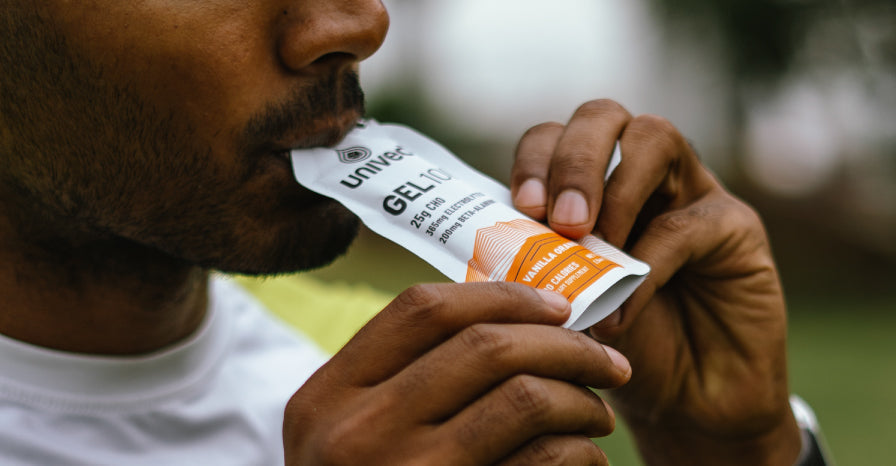
How to Fuel for a Half Marathon: Science-Backed Nutrition with Unived
|Running a half marathon (21.1 km) pushes your body beyond stored energy reserves. Without a solid fueling plan, glycogen depletion, electrolyte imbalance, and hydration challenges can slow you down or even prevent you from finishing strong.
This guide explains how to fuel a half marathon step by step, using Unived Endurance Nutrition products - Gel 100, Gel 180, and Salt Caps - and the sports science behind the strategy.
Why Fueling Matters in a Half Marathon
A half marathon typically lasts between 90 minutes and 2.5 hours for most recreational runners. That’s long enough for three key challenges to emerge:
-
Limited Glycogen Stores
The body stores about 400–500 g of glycogen, enough for ~90–120 minutes of running. Beyond that, energy levels dip unless you refuel mid-race.
-
Carbohydrate Oxidation Rates
Research shows the body can absorb ~60 g/hour from glucose alone, but combining glucose + fructose (multiple transportable carbs) allows up to 90 g/hour. This spares glycogen and delays fatigue¹²⁶.
- Electrolyte Loss Through Sweat
Sodium losses can range from 300–1000 mg/hour. If not replaced, dehydration and cramps can occur³⁴. - Caffeine Support
Moderate caffeine intake (3–6 mg/kg) can boost endurance, focus, and perceived effort⁵.
Unived Half Marathon Fueling Plan
Here’s a proven plan to cover carbs + electrolytes during your race, using Unived endurance products.
Pre-Race (30–45 Minutes Before Start)
-
Unived Gel 100 – 25 g carbs, 100 kcal
-
Drink 200–300 ml water
Why? This primes your glycogen stores and stabilizes blood sugar before the gun goes off.
During the Race
Aim for 50–60 g carbs/hour + sodium replacement.
-
At 30-35 min:
- Unived Gel 180 - 45 g carbs, sustained release
- Provides multi-transportable carbs for efficient absorption and long-lasting energy.
-
At 60–70 min:
-
Unived Salt Cap + ~200 ml water
- Replaces sodium to support hydration and prevent cramps.
-
-
At 80-85 min:
-
Unived Gel 100
- Quick glucose boost to hold pace in the second half.
-
-
At 100–110 min (if finishing >2 hrs):
-
Optional Salt Cap for extra electrolyte support.
-
Post-Race Recovery
-
Carb + protein in a 3:1 ratio for rapid glycogen resynthesis and muscle repair.
-
Rehydrate with fluids and electrolytes.
Fueling Timeline at a Glance
|
Time |
Product |
Role |
|
-30 min |
Gel 100 |
Top-up glycogen |
|
30–35 min |
Gel 180 |
Sustained carbs |
|
60–70 min |
Salt Cap + water |
Replace sodium |
|
80–85 min |
Gel 100 |
Maintain pace |
|
100–110 min (optional) |
Salt Cap |
Electrolytes (if >2 hr finisher) |
Key Takeaways
-
Target 50–60 g carbs/hour during the race.
-
Alternate Gel 100 and Gel 180 to balance fast and sustained energy.
-
Add Salt Caps around the 1-hour mark to maintain electrolyte balance.
-
Prioritize recovery nutrition within 30 minutes post-race.
By following this strategy, you give your body the energy and hydration it needs to perform at its best.
References
- Jeukendrup, A. E. (2010). Carbohydrate and exercise performance: the role of multiple transportable carbohydrates. Current Opinion in Clinical Nutrition and Metabolic Care, 13(4), 452–457.
- Cermak, N. M., & van Loon, L. J. (2013). The use of carbohydrates during exercise as an ergogenic aid. Sports Medicine, 43(11), 1139–1155.
- Hew-Butler, T., Loi, V., Pani, A., & Rosner, M. H. (2017). Exercise-associated hyponatremia: 2017 update. Frontiers in Medicine, 4, 21.
- American College of Sports Medicine, Sawka, M. N., Burke, L. M., et al. (2007). ACSM position stand: Exercise and fluid replacement. Medicine & Science in Sports & Exercise, 39(2), 377–390.
- Spriet, L. L. (2014). Exercise and sport performance with low doses of caffeine. Sports Medicine, 44(Suppl 2), S175–S184.
- Jentjens, R. L. P. G., & Jeukendrup, A. E. (2005). High rates of exogenous carbohydrate oxidation from a mixture of glucose and fructose ingested during prolonged cycling. British Journal of Nutrition, 93(4), 485–492.

